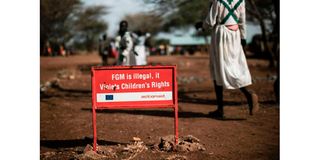It’s time to accelerate action and investment to end FGM in Kenya

A warning sign against FGM in Uganda. Globally, $2.4 billion is needed to eliminate FGM by 2030 in 31 priority countries that include Kenya.
What you need to know:
- The financial cost of healthcare for women living with conditions caused by FGM, puts a significant strain on health systems and budgets.
- FGM elimination programmes that promote the empowerment of girls and women while ensuring adequate services and response for those affected and at risk of FGM can accelerate an end to the practice.
- Progress in the elimination of FGM is evident as girls are one-third less likely to be subjected to the vice today compared to three decades ago.
Female genital mutilation (FGM) is a harmful cultural practice with a high economic burden and lifelong health consequences for survivors. The financial cost of healthcare for women living with conditions caused by FGM, puts a significant strain on health systems and budgets, particularly in hotspot counties with high FGM prevalence rates. The negative health outcomes of FGM encumber women’s and girls’ ability to meaningfully participate in society, negatively impacting on their productivity and entrenching further the cycle of poverty and inequality that drives the practice.
Realising President Uhuru Kenyatta’s commitment to end FGM in Kenya by 2022, and the global abandonment of the practice by 2030, calls for additional resources to urgently scale up ongoing interventions that can prevent this harmful practice, and reduce the impact of its attendant health complications.
Integrated services
FGM elimination programmes that promote the empowerment of girls and women while ensuring adequate services and response for those affected and at risk of FGM can accelerate an end to the practice. Such investments include the provision of integrated services linked to health, education, and economic empowerment, as well as the strengthening of community surveillance and policing mechanisms.
As countries introduce more comprehensive anti-FGM laws and policies, cross-border FGM has emerged as a new trend among practising communities to evade prosecution. A recent study by the anti-FGM Board and UNFPA shows that the border areas of Kenya, Ethiopia, Somalia, Tanzania and Uganda have a higher FGM prevalence rate than the national averages. A costed action plan developed on ending cross-border FGM estimates that at least $13 million will be required to support efforts such as the development of a common regulatory framework and laws in the 5 countries, research and data collection, as well as advocacy at a national and grassroots level.
With commitments made at the Generation Equality Forum (GEF) held in Paris last year, Kenya unveiled a roadmap for increased investments in ending gender-based violence and harmful practices such as FGM through the allocation of US$23 million by 2022, with plans to progressively increase the amount to US$50 million by 2026. The roadmap also outlines measures to strengthen research and innovation for evidence-based policy formulation and programming on gender-based violence and FGM. These investments, coupled with an established legal and policy framework banning FGM, are part of efforts in ending the practice of FGM.
Presidential commitment
While challenges such as the ongoing drought and the Covid-19 pandemic have increased girls’ risk of being subjected to FGM, progress in the elimination of FGM is evident as girls are one-third less likely to be subjected to the vice today compared to three decades ago. However, this progress needs to increase at least tenfold to deliver the Presidential commitment.
Globally, $2.4 billion is needed to eliminate FGM by 2030 in 31 priority countries that include Kenya. The estimate further suggests that the amount of development assistance expected to be spent in these countries from 2020 to 2030 is $275 million, indicating a resource gap of about $2.1 billion.
Empowering girls and women to realise their rights and potential by ensuring access to education, healthcare, and employment opportunities will accelerate the elimination of FGM and contribute to equitable social and economic development. Funding remains the biggest investment needed to achieve this goal through the strengthening of national protection systems and grassroots programmes led by partners working towards eliminating the practice.
With increased investments, the work of grassroots champions, civil society and community-led organizations, and national bodies such as the anti-FGM Board can deliver the realisation of an end to FGM in our lifetime. It’s indeed time to accelerate action and investment to end female genital mutilation in Kenya.
Prof Margaret Kobia Kenya’s Cabinet Secretary, Ministry of Public Service, Gender, Senior Citizens Affairs and Special Programmes, while Dr Ademola Olajide is the UNFPA Representative






